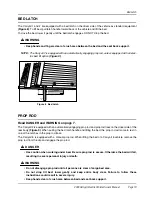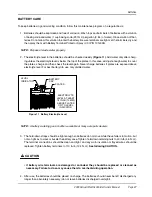
Battery Charger
2003 Carryall Electric Vehicle Owner’s Manual
Page 29
- The plug is too loose or does not make a good connection.
- The plug and receptacle feel hotter than normal during charge.
- The plug pins or contacts are bent or corroded.
- The plug, receptacle or cords are cut, worn, have any exposed wires, or are damaged in any
way.
• Using a charger with any of the above symptoms could result in fire, property damage,
personal injury, or death.
∆
CAUTION
• Do not block or cover the charger ventilation slots. The slots provide ventilation and prevent
the charger from overheating.
• Do not allow clothing, blankets, or other material to cover the charger.
• Do no allow the charger to operate for more than 30 minutes at 19 or more amperes.
• Install surge arrestors on incoming AC power lines. Surge arrestors will help protect electrical
components in the charger and on the vehicle from all but direct or close lightning strikes.
NOTE:
Because the PowerDrive charger has a storage charge feature that automatically checks and
recharges the batteries as necessary every 15 days, it can remain plugged to a PowerDrive vehicle
throughout the storage period.
Shortly after charging begins, the PowerDrive charger will shut off in order to run a self-diagnostic
program (ammeter will drop to zero). Charging will resume in a few moments (ammeter returns to
previous rate of charge). This will be repeated at one hour and at two hours into the charge cycle.
Each Carryall electric vehicle is supplied with either a fully automatic, stationary battery charger (Carryall 1
and Carryall 2) or fully automatic onboard charger (Carryall 6) as standard equipment. The AC cord from the
charger should be connected to a source capable of supplying 10 amperes minimum per charger.
To reduce the risk of electric shock, the battery charger must be grounded. The charger is equipped with an
AC electric cord having an equipment-grounding conductor and a grounding type plug. The AC plug must be
connected to an appropriate receptacle that is properly installed and grounded in accordance with the
National Electrical Code and all local codes and ordinances. See the owner’s manual supplied with the
charger for specific operating instructions before using the charger.
The use of an extension cord with the charger should be avoided. If an extension cord must be used, use a
three-conductor no. 12 AWG (American Wire Gauge) or no. 14 SWG (British Standard Wire Gauge), heavy-
duty cord with ground, properly wired and in good electrical condition. Keep it as short as possible (no more
than 12 feet (3.7 m)). Place all cords so they will not be stepped on, tripped over, or otherwise subject to dam-
age or stress.
Ensure that the charger ventilation slots are unobstructed and that there is adequate ventilation.
Carryall 6 Only:
Because the Carryall 6 vehicle does not have a DC receptacle, the onboard charger must be
repaired in order to charge the batteries.
∆
WARNING
• Vehicles with a charger receptacle: Never modify wiring to bypass the gray sense lead fuse






























